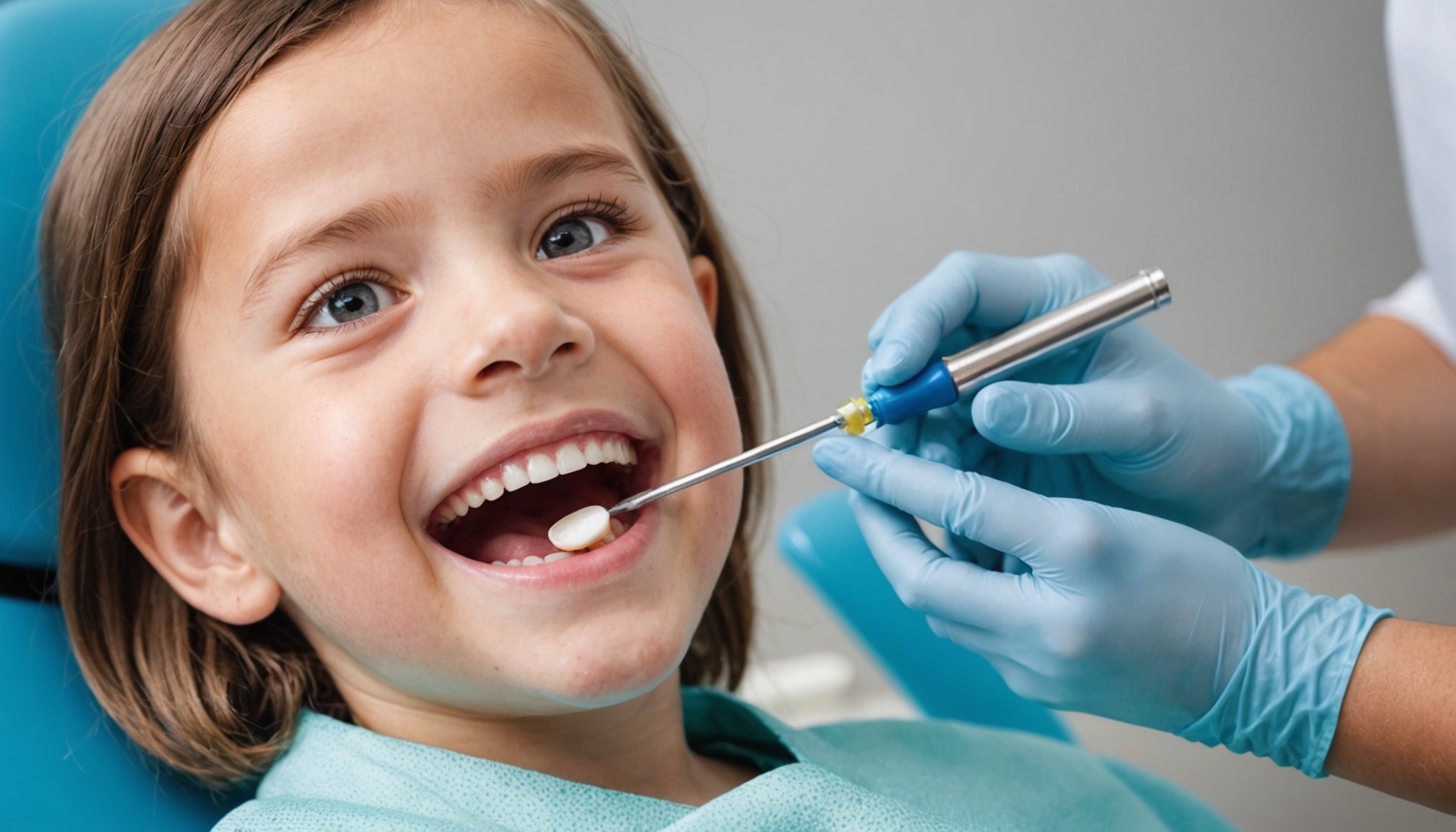Overview of Silver Diamine Fluoride
Silver Diamine Fluoride (SDF) represents a significant advancement in pediatric dental care. Composed primarily of silver, ammonia, and fluoride, it acts as a powerful tool against tooth decay. Historically, its origins trace back to Japan, where it has been used for decades to manage dental caries before gaining approval in other regions, including the United States. The approval marks a milestone in dental healthcare due to its efficacy and safety profile.
The mechanism of action of SDF in cavity prevention involves a chemical reaction where the silver acts as an anti-bacterial agent, and the fluoride helps in remineralisation. This dual action not only halts the progression of cavities but also strengthens the tooth structure. The silver ions in SDF penetrate the dentine and halt bacterial growth, reducing the risk of further decay.
Have you seen this : Unlocking the Power of Essential Oils: Do They Help Alleviate Seasonal Affective Disorder Symptoms?
By understanding its composition and history, dental practitioners can better appreciate its role in modern pediatric dental care. As awareness increases, the integration of SDF into routine dental practices is expected to grow, offering a versatile and effective solution in fighting tooth decay among children. Its simplicity and effectiveness, coupled with its preventive nature, underscore its growing importance in dental therapies.
Benefits of Silver Diamine Fluoride for Cavity Prevention
Silver Diamine Fluoride (SDF) offers numerous advantages in cavity prevention, especially in pediatric dentistry. Its capacity to arrest caries in children is a standout benefit, making it a highly effective option for managing decay. This capability stems from its dual-action mechanism, where silver acts as an antibacterial agent, and fluoride aids in remineralisation, thus halting further advancement of cavities.
This might interest you : Unlocking Comfort: Do Blue Light Blocking Glasses Truly Alleviate Digital Eye Strain?
Unlike traditional methods, SDF excels in being minimally invasive. It avoids the need for drilling or anaesthesia, presenting a more comfortable experience for young patients. This aspect not only reduces potential anxiety for children but also simplifies dental procedures.
Cost-effectiveness is another trait that makes SDF attractive in pediatric dental care. Traditional treatments often require multiple visits and higher costs, whereas SDF is more affordable and can frequently be applied in a single visit. Accessibility improves as a result, allowing a broad range of patients to benefit from its use.
Parents and dental professionals alike appreciate these facets that make SDF a preferred choice for cavity prevention, enhancing current practices with its practical and dependable solutions in pediatric settings.
Application Methods for Silver Diamine Fluoride
The application techniques for Silver Diamine Fluoride (SDF) treatment are straightforward but require precise execution for effective results. Understanding how SDF is applied helps in appreciating its role in dental procedures.
In-office application procedures
Professionals undertake SDF treatment with meticulous care. Initially, the dentist cleans and isolates the tooth using tools such as cotton rolls. Protective equipment is worn by the practitioner to ensure safety. SDF is then applied using a microbrush, allowing it to penetrate effectively. It’s crucial to let the treated area dry for at least one minute, ensuring maximum absorption and efficacy.
Home care practices and follow-up
Upon completion, caregivers receive instructions to maintain oral hygiene and monitor the treated area. Post-application care includes avoiding consumption of stain-inducing foods to minimise tooth discolouration and following dietary recommendations.
Frequency and scheduling of treatments
Typically, an annual SDF treatment suffices; however, bi-annual applications might be required depending on decay severity. Regular dental visits facilitate monitoring of progress and timely reapplication if necessary. This structured approach emphasizes continued engagement between the dental office and home care, enhancing the treatment’s success.
Clinical Evidence and Studies Supporting SDF
Evaluating clinical studies provides a robust understanding of the effectiveness of SDF in managing dental caries. Research consistently highlights SDF’s superiority over traditional remedies in evidence-based dentistry. A substantial body of work underscores its ability to arrest caries progression in children, comparing favourably to conventional fluoride treatments. These studies illustrate not only SDF’s effectiveness but also its practicality as a minimally invasive option, especially where traditional methods may fall short.
Multiple trials reveal promising long-term outcomes for SDF-treated teeth, demonstrating both the durability of treatment and maintenance of oral health over extended periods. Patient satisfaction frequently emerges as a significant finding across various trials, often linked to the non-invasive nature and simplicity of SDF application methods.
Moreover, comparative studies illustrate that while both silver diamine fluoride and traditional treatments have their roles, SDF’s unique properties often render it more effective in environments prioritising preventive care and minimal discomfort. The data affirms SDF’s potential as a preferred method in pediatric dental care, providing a dependable, evidence-supported tool against tooth decay with minimal disruption to the young patient’s experience.
Safety Profile and Side Effects
Silver Diamine Fluoride (SDF) is generally regarded as safe for use in pediatric dental care, with a well-documented safety profile. However, like any dental treatment, it carries certain side effects and risks, which are important for both dental professionals and parents to acknowledge.
Common and Rare Side Effects
One of the most visible side effects of SDF is the staining of treated teeth, a result of the silver component. This blackening is common but temporary, though it can be concerning for some parents. Rare side effects might include gum irritation or a temporary metallic taste.
Discussing Staining and Potential Concerns
The staining of tooth surfaces is often a primary concern for parents. It is essential to clarify that this discolouration indicates the arrest of caries rather than new decay. Dentists should communicate this clearly to help alleviate parental worries.
Long-term Safety Evaluation in Children
Long-term safety evaluations show no substantial adverse effects, affirming SDF’s suitability for repeated use in children. This track record ensures confidence in its application as a preventative tool against tooth decay. Parents should consider the balance between the cosmetic concern of staining and the significant preventive benefits SDF offers.
Real-World Applications in Dental Settings
In many pediatric dentist practices, the implementation of Silver Diamine Fluoride (SDF) is marking a transformative shift in cavity management. Case studies from diverse settings showcase SDF’s unparalleled effectiveness and ease of use. Dentists frequently report that SDF seamlessly integrates into routine dental care, tackling childhood caries elegantly.
Among the compelling examples, a leading pediatric clinic noted a 75% reduction in cavity progression after adopting SDF treatments. Such real-world applications not only underscore its clinical efficacy but also resonate with the practical demands of daily dental management.
Testimonials from both dentists and parents highlight a burgeoning trust in SDF. One dentist emphasised how SDF allowed for managing caries with minimal discomfort, greatly increasing patient cooperation. From the parental perspective, the absence of invasive procedures is a significant relief, aligning well with child-centred care philosophies.
As evidence mounts and more dental professionals share their success stories, SDF’s role becomes increasingly pivotal. Frequently observed are improved outcomes with lower anxiety levels in young patients, bolstering its reputation as a revolutionary tool in pediatric dentistry. The continuing support from the dental community ensures SDF remains a cornerstone of preventive care strategies.
Addressing Parents’ Concerns about SDF
Navigating the myriad parental concerns regarding Silver Diamine Fluoride (SDF) can be challenging for both dentists and families. To ease apprehensions, understanding what drives clinical decisions is crucial. When dentists choose SDF, they consider its proven effectiveness and the child’s specific dental health, ensuring that it is the most suitable option available.
Understanding the Clinical Decision-Making Process
Dentists assess various factors before recommending SDF, such as the severity of tooth decay and the child’s tolerance for conventional procedures. SDF often stands out due to its minimally invasive nature, making it a preferred choice in pediatric dentistry.
Concerns About Pain and Discomfort
Parents often worry about discomfort during dental procedures. With SDF, these concerns can be alleviated — its application is painless, eliminating the need for drilling or anesthesia, which can be unsettling for young patients. Dentists strive to ensure a comfortable experience throughout the treatment.
Clarifying Misconceptions About SDF
Misunderstandings about SDF can lead to unnecessary hesitation. Some parents mistakenly associate SDF with general cavity filling treatments, unaware of its primary role in preventing caries progression. Clear communication with the dentist helps dispel myths, reaffirming SDF’s position as a safe and effective choice in preventive dental care.











